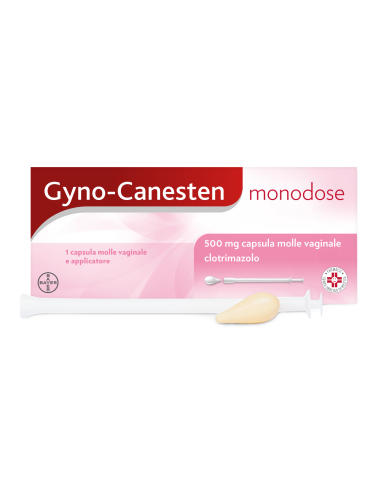Your cart
There are no more items in your cart
Gynocanesten Mono Bench Pharmacies 1cpsvag500mg Gyno Canesten
GYNO-CANESTEN MONODOSE 500 MG CAPSULE WITH A VAGINAL PLUG
active ingredients
A vaginal soft capsule contains 500 mg of clotrimazole. For the full list of excipients, see paragraph 6.1Excellent
Composition of filling material: White soft paraffin; Liquid paraffin. Composition of the dried gelatin shell: Gelatina; Glicerolo; Purified water; Titanium oxide (E171); Chinolin Yellow (E104); Yellow sunset (E110); Lecithin (E322); Medium chain triglycerides.Therapeutic indications
Treatment of vagina infections and external female genital organs caused by microorganisms sensitive to clotrimazole such as mycetes (usually Candidate).Contraindications
Hypersensitivity to clotrimazole or any of the excipients listed in paragraph 6.1.Population
Population Adults and teenagers from 16 years up A vaginal soft capsule inserted deep into the vagina as a single dose in the evening. If there are no improvements after 7 days, the patient should consult a doctor. Treatment can be repeated. However, recurring infections may indicate the presence of a underlying disease. Patient should consult a doctor if symptoms occur repeatedly. Teenagers of 12-15 years of age In teenagers under 16 years, Gyno-Canesten monodose vaginal soft capsule should be used only after consulting the doctor. If prescribed in this population (in post-menarch patients), the recommended dosage is the same as adults. Pediatric population Safety and effectiveness in children under 12 years have not been established. Method of administration The vaginal soft capsule should be inserted as deeply as possible in the vagina with the applicator included in the package, preferably in lying position, in the evening before sleeping. During pregnancy the vaginal soft capsule must be inserted with a finger in the vagina, without the applicator, to avoid injury to the uterine cervix.Conservation
This medicine does not require special precautions for conservation.Warnings
The patient should contact the doctor in case of: • first vaginal infection; • vaginal infection during the first trimester of pregnancy; • recurring infections i.e. more than two infections during the previous six months; • fever (≥ 38 °C); • pain at the bottom of the abdomen, back pain; • malodorant vaginal losses; • nausea; • vaginal hemorrhage and/or at the same time pain behind. Treatment with Gyno-Canesten monodose 500 mg vaginal soft capsule should not be performed during the menstrual period. Treatment must be completed before the beginning of the menstruation. Internal absorbers, vaginal washers, spermicides or other products for vaginal use should not be used in conjunction with this product. During the use of Gyno-Canesten monodose 500 mg vaginal soft capsule, sexual intercourse should be avoided, because the infection could be transmitted to the partner. The partner must also undergo local treatment if it has symptoms such as itching and inflammation. The treatment of the partner can help prevent reinfection. The effectiveness and reliability of latex contraceptives as condoms and diaphragms can be reduced. Vaginal soft capsules should not be swallowed.Interactions
The contemporary use of clotrimazole administered by vaginal and tacrolimus administered by mouth (FK-506, immunosuppressant drug) can lead to an increase in concentrations of tacrolimus in plasma. The same happens with the immunosuppressant drug sirolimus. Therefore, patients taking tacrolimus or sirolimus must be carefully monitored to observe any overdose symptoms if necessary by determining their plasma concentrations. Chlotrimazole is a moderate inhibitor of hepatic microsoenzyme CYP3A4, and a weak inhibitor of CYP2C9 isoenzyme. 3-10% of the local vaginal dose of clotrimazole is absorbed in the systemic circulation, which can have an effect on the concentrations of metabolized drugs through the CYP3A4 isoenzyme in particular, potentially increasing the plasma concentrations of these drugs when used simultaneously. Since the effect on CYP2C9 is poor, and only a small part of locally administered clotrimazole is absorbed in systemic circulation, the effect of clotrimazole on the concentrations of metabolized drugs through CYP2C9 is modest. Therefore, due to the very low absorption of clotrimazole after the vaginal application especially of a 500 mg dose, it is unlikely that clotrimazole applied intravaginalally determines clinically significant drug interactions.Effects
The frequencies shown in the table below come from clinical studies on clotrimazole in formulations for vaginal use.| Classification for systems and organs | Municipality (≥1/100 a | Not common(≥1/1000 a | Rare (≥1/10.000 a |
| Gastrointestinal diseases | abdominal pain | ||
| Immune system disorders | allergic reactions | ||
| Pathologies of skin and subcutaneous tissue | skin rash | ||
| Pathologies of the reproductive apparatus and of the breast | vulvovaginal burning sensation | vulvovaginal itching erythema vulvovaginal | vaginal bleeding |
| Systemic pathologies and conditions for administration | irritation to the application site | edema |
Overdosing
There is no risk of acute intoxication as it is unlikely to manifest itself after a single vaginal application of an excessive dose or after involuntary oral ingestion. There is no specific antidote. During acute clotrimazole overdose, the following adverse reactions were reported: abdominal pain, upper abdomen pain, diarrhea, malaise, nausea and vomiting.Pregnancy
Clinical data in pregnant women are limited, animal studies do not indicate direct or indirect harmful effects in terms of reproductive toxicity (see paragraph 5.3). Clotrimazole can be used during pregnancy. However, during the first trimester of pregnancy, it is recommended to start treatment only under medical control. During pregnancy, the vaginal soft capsules of clotrimazole must be inserted without applicator (see paragraph 4.2). The birth canal should be kept clean especially during the last 4-6 weeks of pregnancy.Food
Data on excretion of clotrimazole in breast milk are not available. However, systemic absorption is minimal after administration and is unlikely to occur systemic effects. Clotrimazole can be used during breastfeeding.Fertility
Human studies have not been conducted on the effects of clotrimazole on fertility. However, studies on the animal have not shown any effect of the drug on fertility.Source: Farmadati
- Deductible product
- Yes
043850015
58 Items
New
No reviews

